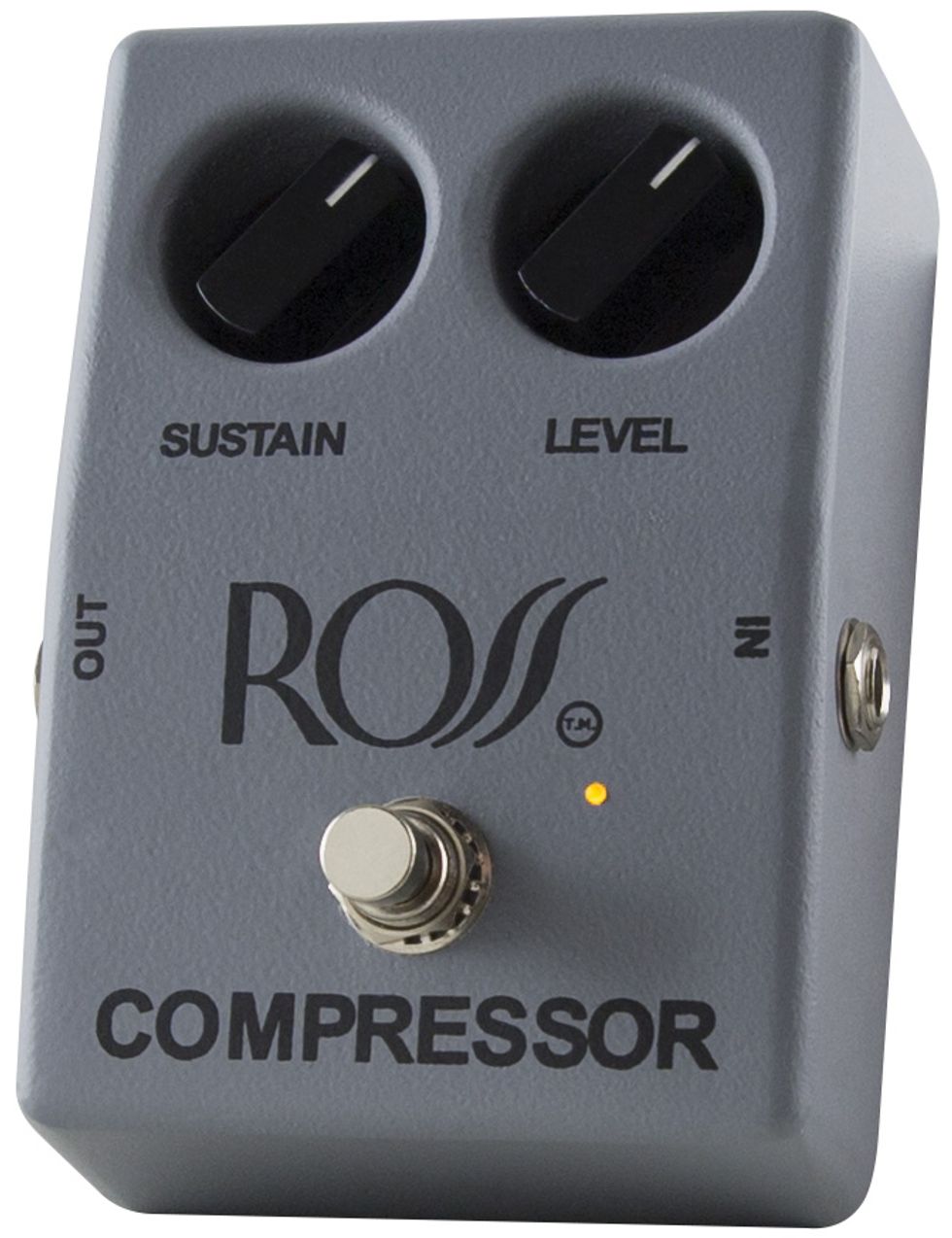Recorded using a Schroeder Chopper TL with Lollar Special T pickups going into a Fender Hot Rod Deluxe IV miked with a Royer R-121 feeding an Apogee Duet going into Studio One with no EQ-ing, compression, or effects.
Clip 1: Sustain and Level knobs at noon.
Clip 2: Sustain at 3 o’clock and Level at 1 o’clock.
RatingsPros:Beautiful vintage-style squish. Less noisy than the originals. Cons: Pricey. Not a lot of options for tone tweakers. Street: $225 Ross Compressor rossaudibles.com | Tones: Ease of Use: Build/Design: Value: |
Who doesn’t like a great comeback story? Especially when it’s about super-hip vintage pedals. In 2018, Cameron Ross (grandson of Ross and Kustom founder Bud Ross) and Ben Brazil decided to bring back the Ross line by meticulously reverse-engineering the pedals. Naturally, the first pair of releases for the revived brand are the Distortion and the grey-box Compressor. Both look exactly like their vintage counterparts. But how does the reissue of this classic compressor hold up?
Still Squishy After All These Years
Way back before parallel compression was all the rage, compressor pedals had a very specific sound—and it wasn’t very subtle. Nor should it be. When you stomped on that grey Ross you knew exactly what you were getting, and this reissue carries that torch. According to Ross, they followed the schematic of the original exactly, right down to how they printed the circuit board. Thankfully, they added a few upgrades including an LED light. (Although I doubt anyone could mistake a vintage Ross Compressor from being on.) Other upgrades include true bypass switching and a Boss-style power jack.
Other descendants from the Ross tree of influence chose to move on from the CA3080e IC that was in the original, but Ross and Brazil chose to keep it in the reissues, which I would say contributes to that Ross sound in a big way. Even though vintage models could struggle with noise, I found the reissue to be a bit quieter. But let’s face it, if you’re using a good amount of compression and gain, there’s going to be some noise.
With any vintage-style compressor, I start with the knobs at noon and season to taste. On more modern compressors you could find controls for attack, sustain, ratio, and threshold, among others. In the Ross circuit all of those are wrapped into a single sustain knob. This is great news for the set-and-forget crowd, but not as interesting for players who love to turn and tweak knobs.
Depending on how hard you play, the sustain knob might not do much until you get past noon. I found my sweet spot was right around 1 o’clock, and it gave my Schroeder Chopper TL that chicken’ picking sound I heard on so many old country albums. The slow attack allowed for the occasional transient to pop through before the compression hammer came down. To me, this is a sign of a faithful reissue of the early Ross compressors.
Something’s Phishy
In the ’90s, the Ross Compressor had a resurgence thanks to Phish’s Trey Anastasio. Gear-minded Phish heads dug deep into his rig and found that the Ross comp was a crucial element. It went to such a feverish level that when Anastasio removed the pedal from his rig, fans banded together to chip in and purchase a vintage model for him. It was a symbolic gesture, but the pedal did make its way back into Anastasio’s rig.
The typical setup for Trey’s smooth, singing lead tone was to add the Ross with a Tube Screamer-style overdrive. I reached for a Jackson Audio Broken Arrow and dug in. From the research I did, it looked like Trey would keep the sustain knob around 9 o’clock and the output just past noon. The single-coils in my Schroeder responded well to the dirty squish, but I found that the sustain needed to be boosted just a bit. This is likely due to the lower output of the T-style pickups. The Ross did play well with other overdrives. Quite impressively, actually, since it has such a specific sound for a compressor. One minor quibble would be that the range of the sustain knob could be a bit more nuanced, as I found not much action happening below 11 o’clock.
The Verdict
If you’re looking to use compression as a central part of your tone and want to keep it dead simple, then you’d be remiss to overlook the Ross Compressor, even if the nostalgia factor isn’t there for you. Yeah, it’s a bit pricey for a simple two-knob compressor, but the sound of the Ross squish is pretty unmistakable, and for some comp addicts the grey box is the only way to go.








![Rig Rundown: Russian Circles’ Mike Sullivan [2025]](https://www.premierguitar.com/media-library/youtube.jpg?id=62303631&width=1245&height=700&quality=70&coordinates=0%2C0%2C0%2C0)

















